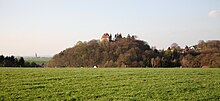Berkule
Berkule (also Bercule ) is the name of a Westphalian noble family of knighthood . In the 13th century they ruled the area south of Warburg around the village of Holthusen, which has since disappeared . The Counts of Callenberg with the same tribal and coat of arms emerged from them

history
In 1191 Hermann and Bernhard Berkule are mentioned as builders of the Holsterburg . They owned the village of Holthusen in the Diemeltal , first mentioned in 1170 , whose control they apparently wanted to secure by building a castle. Since their best people then fled to the city of Warburg , which was founded at the same time , Hermann Berkule signed a contract with the old town of Warburg in 1240, in which the city undertook to accept its farmers only with its consent. At the Wartberch Castle there , which belonged to the Paderborn Monastery, since Count Dodiko had inherited his county to the bishop in 1020 , members of the Berkule family also served as burghers , together with the Rabe von Pappenheim and the von Horhusen .
Around 1250, the Berkule knights also built the hilltop castle Calenberg , after which the lords and counts of Callenberg of the same tribe and coat of arms named themselves.
In 1265, "the noble" Herman called Bercule (Bircule) belonged as the first-named to a 12-strong knight college, which was set up by Bishop Simon I of Paderborn with the Hessian Landgrave Heinrich I to ensure a 3-year peace . Other representatives of the bishop were Hermann Spiegel , Marshal Ludolf, Rudolf von Steinfurt , Elias von Asseln and Albert von Welda . The Hessian side was represented by Count Albert von Wallenstein (Waldensten) , the brothers Giso and Werner von Gudensberg (Edle), Johann von Helfenberg , Giso von Gudenburg and Heinrich von Blumenstein (Blumensten) .
In 1294 Johann Berkule , possibly a son of Hermann, was in open conflict with the Paderborn Monastery. Apparently there were again disputes with the city of Warburg, possibly because of assaults on goods transports, about which the city had complained to its sovereign. Bishop Otto , Simon’s successor since 1277, therefore founded an alliance of the cities of Warburg, Marsberg , Höxter , Fritzlar , Hofgeismar , Wolfhagen and Naumburg against the Knights Berkule on November 6th of that year and had the Holsterburg stormed and destroyed. Some of the captured knights were executed. Around 1300 Calenberg Castle also fell to the Paderborn Bishop Otto, who in 1307 occupied it with his followers, the knights Rabe von Pappenheim , to whom he transferred the castle. Johann Berkule submitted to the bishop, who then made him one of his castle men in Warburg . In 1316 he was mentioned again as a witness.
There are still descendants of the family in the Rhineland and the USA.
coat of arms
The coat of arms shows two crossed red morning stars in silver with a red rose in between.
It is the family coat of arms of their agnates , the later Counts of Callenberg .
swell
- March 16, 1265, peace between Paderborn and Hesse. Regest no. 109. Regest of the Landgraves of Hesse. In: Landesgeschichtliches Informationssystem Hessen (LAGIS).
- Warburg City Archives, Certificate No. 6 of November 11, 1294
- Westphalian Document Book 9, No. 1488, Urschr. StA Münster, Hardehausen Monastery, Document No. 449 of November 10, 1316
Individual evidence
- ↑ Max von Spießen: Book of arms of the Westphalian nobility, with drawings by Professor Ad. M. Hildebrandt, p. 26, 1st volume, Görlitz 1901–1903 - digitized
- ↑ Max von Spießen: Book of arms of the Westphalian nobility, with drawings by Professor Ad. M. Hildebrandt, p. 73, 1st volume, Görlitz 1901–1903 - digitized

